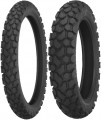Season
The season (and, accordingly, the temperature regime) for which the tyre is designed.
"Seasonality" is primarily due to the fact that any composition used in the construction of motorcycle tyres has a certain temperature range in which it shows optimal performance. If the temperature is too low, the rubber will remain hard and will not provide the desired degree of grip, and if it is too high, it will soften, impair stability and be subject to increased wear. In addition, winter and all-season models often have specific design features that ensure efficient operation in difficult conditions — special-shaped grooves for effective moisture removal, massive protrusions for “biting” into the snow, etc. Therefore, it is highly undesirable to deviate from seasonal recommendations.
At the same time, it is worth noting that motorcycles themselves as a mode of transport are designed mainly for use in the warm season — by the word "season" most owners of motorcycles mean the period from approximately mid-spring to mid-autumn. Therefore, the vast majority of motorcycle tyres are
summer tyres,
all-season models are very rare, and winter tyres are even rarer, mainly among
cross -country rubber (see above).
Width
Nominal tire profile width in inches. This designation is quite widely used in motorcycle tires along with millimeters (see the corresponding paragraph). However, the meaning of such designations differs: the actual width is indicated in millimeters, and inches essentially indicate a kind of general tire size. One inch standard size often includes several width options in millimeters, and this width depends on the height of the profile. You can determine the exact dimensions of inch tires using special tables.
As for the width in general, this is one of the parameters that determines compatibility with a specific rim (another parameter is the mounting size, see above for details). The main criterion for choosing a tire width is the manufacturer's recommendations for a given motorcycle model. It is highly undesirable to deviate from these recommendations: although some types of motorcycles (for example, road) allow a deviation in width of +/- 10 mm on the rear wheel, such a wheel will still function in a mode different from the standard one. On the front wheel, no deviations are allowed at all.
Today, the market offers mainly tires in the following widths in inches:
2",
2.25",
2.5",
2.75",
3",
3.25",
3.5",
4",
5.
Load index
The load index indicates
the maximum weight load that the tyre can safely carry in normal operation. To shorten the marking, this parameter is denoted by a two-digit number; you can translate this designation into a specific weight in kilograms using special tables.
This value must not be exceeded — otherwise the tyre may burst at any time due to off-design loads. At the same time, when choosing motor tyres for this parameter, it is worth remembering that the load is distributed unevenly between the front and rear wheels. However, the task is facilitated by the fact that motorcycle manufacturers can indicate the minimum or recommended load indices for the front and rear axles in the documentation for their equipment.
Speed rating
The speed rating characterizes the maximum speed at which the tyre maintains performance, in other words, the highest speed at which you can safely drive when using this tyre in normal mode (on the “native” axle, with normal load, etc.). This parameter is indicated by Latin letters, each of which corresponds to its own maximum speed value — for example, a value of 210 km/h is denoted as H. The most modest modern tyres, used mainly for scooters and motocross motorcycles, have the index J (100 km/h), and in high-speed sports models there are models of the
W level (270 km/h).
You should choose a tyre for this parameter based on the recommendations of the motorcycle manufacturer, and if there are no such recommendations, then with a margin of at least 10-15 km/h in excess of the maximum speed with which you plan to ride; this will give an additional guarantee of safety in case of emergency situations. It is technically OK for most motorcycles to use tyres that are less fast than recommended, but in fact this should not be done. And the point is not only that the driver will have to limit the speed of movement — such tyres are generally less durable than high-speed ones and may not tolerate sharp accelerations well.
